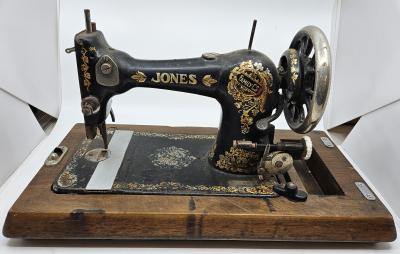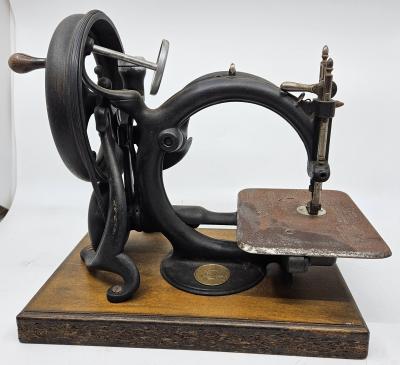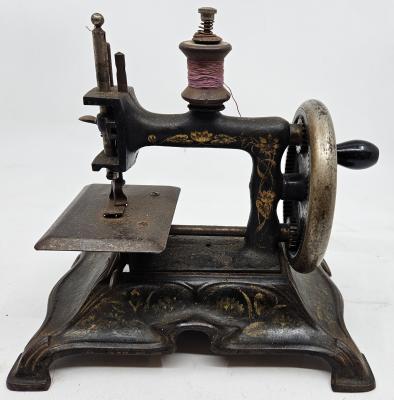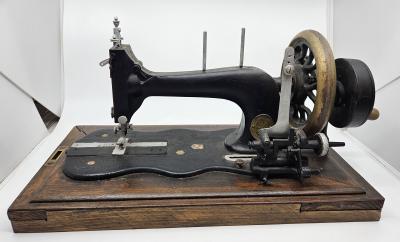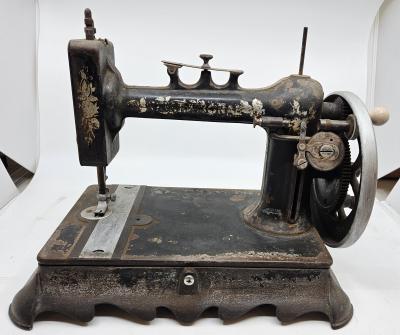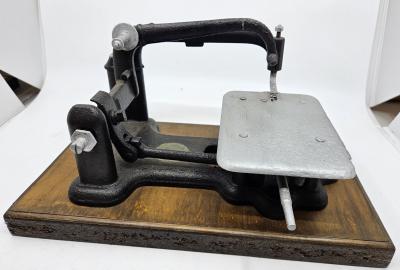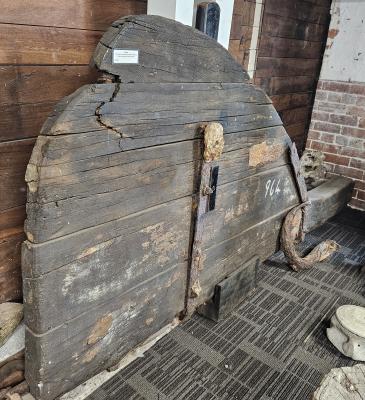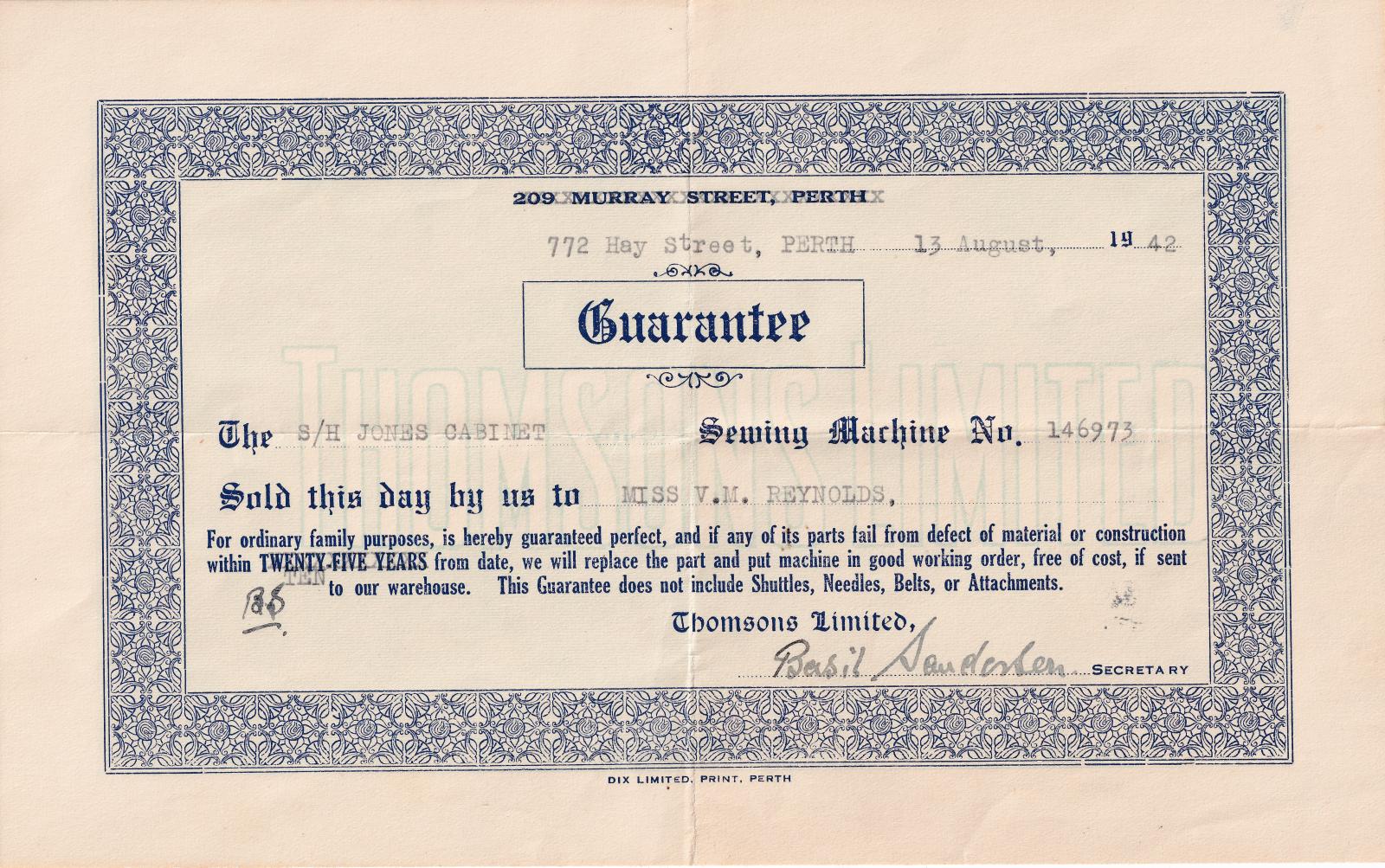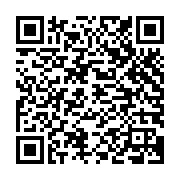Jones Medium CS Type8 Sewing Machine
1928The machine is powered mechanically by a foot treadle which is pushed back and forth by the operator’s foot, which is connected to the machine by a continuous leather belt.
The Jones Medium CS (Cylinder Shuttle) has a 14.5 inch bed and was designed for use by seamstress’s and tailors. Approximately 180,000 of these machines were made and production ceased shortly after the start of World War 2.
The machine is housed in a wooden ‘Jones Parlour Cabinet’ 800mm high, 670mm wide and 480mm deep, sitting on four non-swivelling metal wheels. The cabinet lid hinges open to the left forming a work table supported by a wooden 460mm pull-out brace. By opening the hinged top front panel of the cabinet, the machine can be rotated up into its working position, this is then held in position when the top front panel is closed.
Two vertically hinged doors at the front of the cabinet open to reveal the treadle and associated flywheel, which is connected to the machine via a leather belt. The insides of the doors are fitted with wooden non-removable storage trays.
The Jones Sewing Machine Co. Ltd. started life in the town of Audenshaw, just east of Manchester and now next to the M60. In 1859, William and his brother John of Shepley Street, Audenshaw set up a business producing domestic sewing machines. At the time William owned an engineering firm producing very small steam engines.
Not long after they started they formed a partnership with Thomas Chadwick, trading as Chadwick and Jones. This didn’t last long, as in 1864 Thomas Chadwick went to work for Bradbury and Co., a rival sewing machine manufacturer.
Just 10 years later, in 1869, William Jones opened purportedly the largest factory in England at Guide Bridge, a few miles east of Audenshaw and the firm was registered as a limited company in 1879. The Jones factory produced a wide variety of machines for both domestic and industrial use, most noticably heavy industrial machines for Burton’s the tailors.
Most of the machines produced had equivalent Singer models but with various differences. The ‘Jones Family’ and ‘Jones Medium Transverse Shuttle’ were very similar models to the Singer 12 and 13.
The early Serpentine models did not have a take up lever and the tension discs were mounted on the arm of the machine instead of the faceplate. By around 1883 the faceplate was brass plated with the tension discs mount on it and the decals over the top arm of the machine were ornate vine leaves. By the end of the 1880’s the faceplate was nickel plated and in the centre of the machine bed a decal proclaimed ‘Jones Hand Machine’. A couple of years later this decal was replaced with a brass boss showing a gryphon and the words ‘Jones Hand Machine’. Stamped into the round cloth plate are two stamps The first with the words ‘As supplied to H.R.H. Princess of Wales’ and ‘Jones Hand Machine’ and the second with ‘Jones Sewing Machine Compy Ltd’ and ‘Jones & Compy Guide Bridge, Nr Manchester’ with a trade mark bird with outstretched wings. The Jones Serpentine was also badged for sale under the names of different retailers and special limited edition versions were produced until 1907.
In 1957 the Jones Company was sold to the Imperial And Continental Gas Association. ICGA already owned E. Harris Ltd. which made sewing machines under the Vickers and BSM names. It appears that E. Harris may well have become involved with the distribution of the Jones machines at this time. By 1962 ICGA had sold its sewing machine business at a minimum book value to the Brother International Group of Japan. They are still today producing sewing machines at the old Jones factory under the Brother name.
https://www.singersewinginfo.co.uk/antiques/jones
Details
Details
Jones Medium CS (Cylinder Shuttle)
Guide Bridge
Factory
Nr Manchester
Serial No. 146973
This machine was purchased second hand by Miss Virginia Reynolds who was a descendant of the Prinsp family. She married Ernest Wells and they farmed near Busselton until moving to Perth in the 1950's. This machine is in excellent working order and has the original guarantee given when Miss Reynolds purchased it in 1942
More items like this
Other items from Busselton Historical Society
- Willcox & Gibbs Sewing Machine
- Toy Sewing Machine
- Jones Hand Operated Sewing Machine
- Frister & Rossman Sewing Machine
- Treadle Sewing Machine. Ruby.
- Florence Sewing Machine
- ANA Sewing Machine
- Singer 66K Sewing Machine
- New National Sewing Machine
- Wheeler & Wilson Sewing Machine
- Wash Stand owned by Captain John Molloy
- Ship's Rudder
